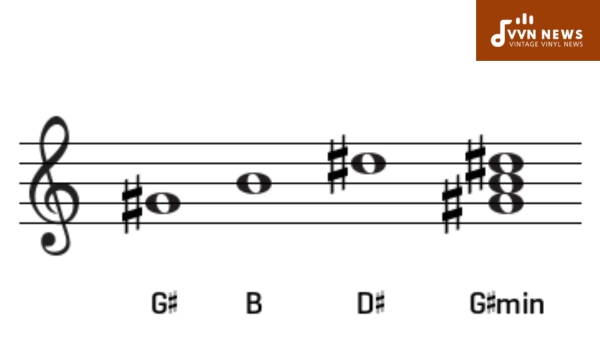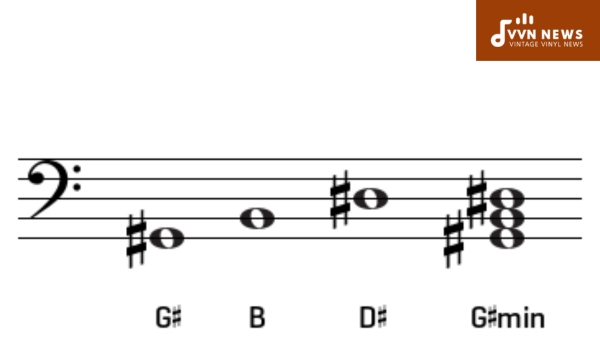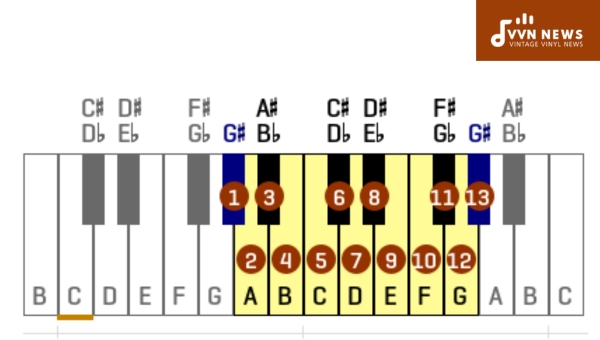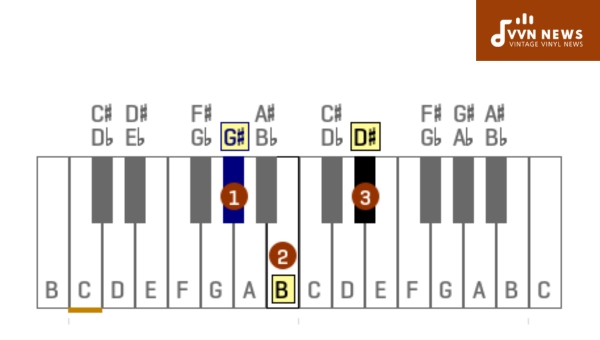Stepping into the world of music theory can seem daunting at first, but some elements, like the widely used G sharp minor triad, are relatively simple to comprehend.
This three-note chord is an essential building block for compositions across countless genres, from classical to pop.
So, if you’re a songwriter or musician looking to deepen your knowledge of music theory and contribute more coherently to your melodies, continue reading as we unravel the foundations of the G sharp minor triad.
In our exploration today, we will enhance our musical vocabulary and decode how to master this triad for its best usage.
The G sharp minor triad might appear complex on paper but once you delve into its structure and characteristics, it is indeed simple harmony serving multifaceted roles in musical compositions.
So let’s step into this fascinating part of music theory without any delay.
What is a G Sharp Minor Triad?
A G sharp minor triad is a three-note chord composed of the notes G#, B, and D#. This triad belongs to the G sharp minor scale and is widely used in music across various genres.
It is categorized as a minor triad because it contains a flattened third-degree (B) compared to its major counterpart.
The G sharp minor triad has a distinctive sound that is often described as melancholic or introspective.
The structure and characteristics of this triad will allow musicians to incorporate it into their compositions, adding depth and emotion to their music.
How to Construct a G Sharp Minor Triad?

Constructing a G sharp minor triad involves the intervallic relationships between its constituent notes – G#, B, and D#. Here are the steps to construct a G sharp minor triad:
- Start with the root note: The root note of the triad is G#. It serves as the foundational pitch from which the rest of the triad is built.
- Determine the third note: To find the third note of the triad, count up three half steps (or semitones) from the root note. In this case, counting up three-half steps from G# gives us B.
- Find the fifth note: Count up an additional four half steps (or semitones) from B to find the fifth note of the triad. In this case, counting up four half steps from B gives us D#.
- Arrange the notes in ascending order: Once you have identified all three notes – G#, B, and D# – arrange them in ascending order to create the G sharp minor triad: G#, B, D#.
By following these steps, you can construct a G sharp minor triad and explore its unique tonal qualities within your musical compositions or improvisations.
Also Read: D Minor Pentatonic Scale [Make Your Music Sing With Emotion]
Key Characteristics of G Sharp Minor Triads
The G sharp minor triad possesses several key characteristics that make it a fascinating and versatile chord in music:
- Structure: A G sharp minor triad consists of three notes – G#, B, and D#. The first note, G#, is the root of the chord, while B is the flattened third degree and D# is the fifth degree.
- Tonality: G sharp minor triads have a distinct tonal quality that evokes emotions like sadness, introspection, or mystery. It exhibits a dark and somber sound which can add depth and complexity to compositions.
- Melodic Possibilities: Due to its unique structure, the G sharp minor triad lends itself well to melodic exploration. Musicians can utilize its colors and tonal qualities to create captivating melodies or harmonies.
- Harmonic Function: In the context of music theory, the G sharp minor triad typically serves as a tonic chord in the key of G# minor. It provides stability and resolution within compositions.
- Chord Progressions: The G sharp minor triad can be used in various chord progressions to create tension, release, or color in a musical piece. Pairing it with other chords can enhance its emotional impact while creating interesting harmonic movements.
- Instrumentation: The G sharp minor triad can be played on a wide range of instruments such as piano, guitar, violin, or even synthesizers. Each instrument adds its unique timbre and expression to this chord.
- Common Usage: Artists across genres have employed the G sharp minor triad in their compositions to evoke specific emotions or create an atmospheric ambiance. Its versatility allows it to be used in various styles such as classical, jazz, rock, or pop music.
These key characteristics of the G sharp minor triad enable musicians to employ this chord effectively within their compositions, adding depth and emotional impact to their musical creations.
How Does G Sharp Minor Triad Compare to Other Minor Triads?

When comparing the G sharp minor triad to other minor triads, it is important to consider its unique qualities and how it differs from its counterparts. Let’s explore some key points of comparison:
Chord Structure
The G sharp minor triad consists of the root note G#, the minor third B, and the perfect fifth D#.
This structure remains consistent across all minor triads. However, the specific notes used in each triad will vary depending on the root note.
Key Signature
The G sharp minor triad belongs to the key of G# minor, which has a complex key signature with five sharps (F#, C#, G#, D#, and A#). This differs from other common minor keys such as A minor or E minor.
Also Read: D Sharp Minor Pentatonic Scale [Inject Drama Into Your Melodies]
Tonality
The tonal qualities of the G sharp minor triad differ from other minor triads due to its unique notes.
The flattened third (B) in comparison to a major chord gives it a dark and melancholic sound, evoking emotions of sadness or introspection.
Harmonic Function
In terms of harmonic function, the G sharp minor triad shares similarities with other minor chords. It can serve as a tonic chord in the key of G# minor, creating a sense of resolution and stability.
Its use can also extend beyond this function depending on the context within a musical piece.
Role in Composition
The G sharp minor triad is commonly used in various genres such as classical, jazz, pop, and rock music to convey different moods and emotions.
Its versatility allows it to be incorporated into chord progressions, melodies, solos, and harmonies.
These comparisons between the G sharp minor triad and other minors will help musicians make informed choices when creating chord progressions, harmonies, and melodies, ultimately adding depth and complexity to their compositions.
How to Play G Sharp Minor Triad on Different Instruments?
Playing the G sharp minor triad on various instruments requires finger positions or fretboard positions specific to each instrument.
Here’s a breakdown of how to play the G sharp minor triad on popular instruments:
Piano/Keyboard:
- Locate the G# key on the keyboard. It is the black key immediately to the right of the G key.
- Place your thumb on the G# key, your middle finger on the B key (white key to the right of A), and your pinky finger on the D# key (white key to the right of D).
- Press all three keys simultaneously to play a G sharp minor triad.
Guitar:
To play a G sharp minor triad on guitar, you can use different chord shapes depending on your playing style and preference. Here are a few common ways:
Barre Chord Shape:
- Barre your index finger across all strings at the 4th fret.
- Place your ring finger on B string, 6th fret.
- Place your pinky finger on D string, 6th fret.
- Strum from the A string down for a full-sounding chord.
E Chord Shape:
- Position your ring finger on the 6th string, 4th fret (G#).
- Position your middle finger on the 5th string, 3rd fret (B).
- Position your index finger barring across strings 4-1, 2nd fret (D#).
- Strum from E string down for a bright and open sound.
A Chord Shape:
- Barre all strings at the 11th fret with your index finger.
- Position your ring finger on B string, 13th fret.
- Position your pinky finger on the D string, 13th fret.
- Strum from the A string down to the high E string.
Bass:
To play the G sharp minor triad on bass guitar:
- Position your index finger on the 4th fret of the E string.
- Use your middle finger to press down the D string at the 6th fret.
- Finally, place your pinky finger on the 6th fret of the G string.
- Pluck these three strings together to play a G sharp minor triad.
Also Read: G Flat Minor Pentatonic Scale [Interesting Tones For Your Music]
Ukulele:
To play a G sharp minor triad on ukulele:
- Place your middle finger on the A string, 4th fret (G#).
- Position your ring finger on the C string, 3rd fret (B).
- Place your pinky finger on the E string, 4th fret (D#).
Strum all four strings of the ukulele for a harmonious G sharp minor triad sound.
Learning how to play the G sharp minor triad allows musicians to incorporate its unique qualities into their compositions and improvisations across different instruments.
Experiment with various positions and inversions of this triad to explore its full potential in your musical journey.
What are the Inversions of G Sharp Minor Triad?

Inversions are different ways of voicing a chord by rearranging its notes. They offer musicians and composers alternative ways to play and structure chords, providing versatility and harmonic interest in their compositions.
The G sharp minor triad has three inversions: the first inversion, the second inversion, and the root position. Let’s explore each inversion in detail:
First Inversion:
- In a first inversion G sharp minor triad, the B note becomes the lowest note or bass note.
- The first inversion is represented as G#m/B in chord notation.
- This inversion creates a unique sound and adds richness to the chord progression.
Second Inversion:
- In a second inversion G sharp minor triad, the D# note becomes the lowest note or bass note.
- The second inversion is represented as G#m/D# in chord notation.
- This inversion provides a smooth transition between chords and can create a sense of tension if used dynamically.
Root Position:
- The root position of a G sharp minor triad has G# as its lowest note or bass note.
- The root position is represented as G#m in chord notation.
- It is the default or most common way to play this triad.
Inversions offer musicians multiple ways of voicing chords, allowing for more diverse and interesting musical compositions.
Each inversion of the G sharp minor triad has its unique sound and can be used to evoke different emotions within a piece of music.
What are the Triads From G Sharp Minor?
The G sharp minor scale consists of seven different notes. Each note becomes the root of a triad, creating a set of triads that can be derived from the G sharp minor scale. Let’s explore each triad in detail:
- G# Minor Triad: The G# minor triad is the chord that corresponds to the tonic, or the first degree, of the G sharp minor scale. It is built by stacking a minor third (G# to B) and then a major third (B to D#) on top of each other.
- A# Diminished Triad: The A# diminished triad is formed by stacking two minor thirds (A# to C# and C# to E) on top of each other. It is considered a diminished triad due to its unique interval structure.
- B Major Triad: The B major triad is built by stacking a major third (B to D#) and then another major third (D# to F#). This triad provides a bright and uplifting sound within the context of the G sharp minor scale.
- C# Minor Triad: The C# minor triad follows a similar pattern as the first degree, but with a different starting note. It consists of C#, E, and G#, creating a melancholic quality similar to the tonic, but with its distinct flavor.
- D# Minor Triad: The D# minor triad features D#, F#, and A#. Like the previous two, it carries an introspective quality but remains unique in its relationship with the other notes in the scale.
- E Major Triad: The E major triad brings brightness and stability into play within the G sharp minor scale. It consists of E, G#, and B, forming two major thirds on top of each other.
- F# Major Triad: The F# major triad is the final triad derived from the G sharp minor scale. It consists of F#, A#, and C#, providing a contrasting and uplifting sound within the minor tonality.
The various triads that can be formed from the G sharp minor scale provide musicians with a palette of harmonic possibilities.
Incorporating these triads into compositions allows for creative exploration and adds depth and emotion to musical arrangements.
Also Read: G Minor Pentatonic Scale [Create Engaging Solos & Improvisations]
Chord Progressions with G Sharp Minor Triad
Chord progressions are an essential aspect of creating interesting and dynamic musical compositions.
The G sharp minor triad can be incorporated into a variety of chord progressions, lending a unique and emotive flavor to the overall sound.
Here are some common chord progressions that include the G sharp minor triad:
G#m – C# – D#m – F
This progression begins with the G sharp minor triad, then moves to the C sharp major chord, followed by the D sharp minor and F sharp major chords. This progression creates a sense of tension and resolution.
B – G#m – E – F
Starting with the B major chord, this progression seamlessly transitions to the G sharp minor triad, then moves to E major and F sharp major. This progression has a melancholic quality that evokes deep emotions.
C# – A#m – B – G#m
Beginning with the C sharp major chord, this progression includes the A sharp minor, B major, and G sharp minor triads. It creates a sense of tension in the first half before resolving back to the initial key.
D#m – F# – A#m – C
Starting with the D sharp minor triad, this progression moves to F sharp major, A sharp minor, and finally resolves on C sharp major. It has a contemplative feel that works well in slower-paced songs.
By incorporating these chord progressions into your compositions or improvisations, you can explore various emotions and create unique musical experiences using the depth and beauty of the G sharp minor triad.
What are Some Famous Songs Featuring G Sharp Minor Triad?
The G sharp minor triad has made appearances in numerous popular songs across various genres. Here are some famous examples:
- “Someone Like You” by Adele: This iconic ballad showcases the emotional power of the G sharp minor triad. The chord progression of G#m – E – B – F# creates a haunting and melancholic atmosphere, perfectly complementing Adele’s heartfelt vocals.
- “Imagine” by John Lennon: Lennon’s timeless masterpiece features the G#m chord in the chorus. The sequence of G#m – A – B gives the song a dreamlike quality, emphasizing the message of unity and peace that Lennon was advocating for.
- “Firework” by Katy Perry: Perry’s uplifting anthem includes the G#m chord in its chorus section, adding a touch of tension and complexity to the otherwise upbeat track. The chord progression of G#m – E – B creates a sense of release and empowerment when it resolves to the major chords.
- “With or Without You” by U2: This classic rock ballad by U2 incorporates the haunting tones of the G#m chord throughout its verses and chorus. The repetition of G#m – E – B creates a sense of longing and intensity that perfectly complements Bono’s powerful vocals.
- “Drive” by Incubus: In this alternative rock hit, Incubus employs an acoustic-driven sound with the prominent use of the G#m chord in its main riff and chorus progression. The minor undertones add depth and emotion to the song’s introspective lyrics.
- “Back to Black” by Amy Winehouse: Winehouse’s soulful track features elements of jazz, R&B, and pop music, with the G#m chord appearing throughout its verses and chorus sections. This chord choice helps create a somber and evocative atmosphere that matches the song’s poignant lyrics.
- “Stairway to Heaven” by Led Zeppelin: Considered one of the greatest rock songs of all time, “Stairway to Heaven” utilizes the G#m chord in its iconic guitar solo section. The ethereal tones of the G#m chord add a touch of mystique and grandeur to this epic rock masterpiece.
These are just a few examples of famous songs that feature the G sharp minor triad. By listening to and studying these tracks, musicians can gain inspiration for their compositions and see how the G sharp minor triad contributes to the emotional impact of a song.
Also Read: F Sharp Minor Pentatonic Scale [How To Use In Your Compositions]
FAQs about G Sharp Minor Triad
What are the notes in a G sharp minor triad?
The G sharp minor triad consists of the notes G#, B, and D#.
Is the G sharp minor triad commonly used in music?
Yes, the G sharp minor triad is widely used in various genres of music due to its unique tonal characteristics.
Are there any inversions of the G sharp minor triad?
Yes, the G sharp minor triad has three inversions: B – D# – G#, D# – G# – B, and D# – B – G#.
How can I play a G sharp minor triad on different instruments?
On the piano, you can play a G sharp minor triad by pressing down the keys for G#, B, and D#. On guitar, you can form the chord by placing your fingers on the corresponding frets for each note.
Can you provide examples of songs that feature the G sharp minor triad?
Some famous songs that incorporate the G sharp minor triad include “Someone Like You” by Adele and “Forever Young” by Alphaville.
Conclusion
The G sharp minor triad is a powerful chord that adds depth and emotion to musical compositions.
Its unique tonal qualities make it a popular choice among musicians in various genres.
With the structure, characteristics, and inversions of this triad, musicians can create captivating chord progressions and melodies.
Whether you are a composer, instrumentalist, or music enthusiast, incorporating the G sharp minor triad into your repertoire will undoubtedly enhance your musical expression and creativity.
Explore its potential and let this triad take your musical compositions to new heights.








